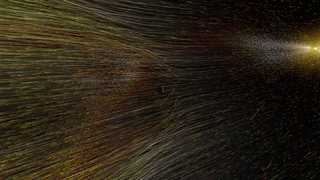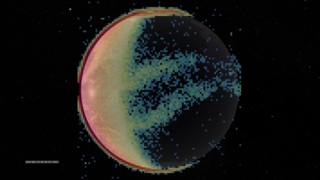Earth
Sun
ID: 4762
The GOLD instrument aboard the SES 14 satellite observes the Earth in ultraviolet light. In this region of the electromagnetic spectrum, it sees emission of atmospheric ions, atoms and molecules activated by incoming solar radiation.
In these visualizations, we see how the total solar eclipse of July 2012 significantly affected this emission as the Moon's shadow moved across Earth. We also show wavelengths corresponding to two different populations of emitting atoms, the nitrogen LBH bands and the oxygen 135.6nm emission which has a strong contribution from ionized oxygen atoms.
Because the oxygen ions are charged, they respond to the electromagnetic force and exhibit some enhancement straddling the magnetic equator - the Appleton anomaly, which is created by a process called the 'fountain effect'. The nitrogen emission, from atoms with no net electric charge, does not respond to Earth's magnetic field so does not exhibit the Appleton anomaly.


GOLD Instrument observes the July 2019 Total Solar Eclipse
In these visualizations, we see how the total solar eclipse of July 2012 significantly affected this emission as the Moon's shadow moved across Earth. We also show wavelengths corresponding to two different populations of emitting atoms, the nitrogen LBH bands and the oxygen 135.6nm emission which has a strong contribution from ionized oxygen atoms.
Because the oxygen ions are charged, they respond to the electromagnetic force and exhibit some enhancement straddling the magnetic equator - the Appleton anomaly, which is created by a process called the 'fountain effect'. The nitrogen emission, from atoms with no net electric charge, does not respond to Earth's magnetic field so does not exhibit the Appleton anomaly.


Related
Visualization Credits
Tom Bridgman (Global Science and Technology, Inc.): Lead Visualizer
Kathalina Tran (SGT): Lead Producer
Genna Duberstein (USRA): Lead Producer
Saurav Aryal (LASP, University of Colorado Boulder): Scientist
Laurence Schuler (ADNET Systems, Inc.): Technical Support
Ian Jones (ADNET Systems, Inc.): Technical Support
Kathalina Tran (SGT): Lead Producer
Genna Duberstein (USRA): Lead Producer
Saurav Aryal (LASP, University of Colorado Boulder): Scientist
Laurence Schuler (ADNET Systems, Inc.): Technical Support
Ian Jones (ADNET Systems, Inc.): Technical Support
Please give credit for this item to:
NASA's Scientific Visualization Studio
NASA's Scientific Visualization Studio
Short URL to share this page:
https://svs.gsfc.nasa.gov/4762
Mission:
Global-scale Observations of the Limb and Disk (GOLD)
Data Used:
Note: While we identify the data sets used in these visualizations, we do not store any further details nor the data sets themselves on our site.
This item is part of this series:
Interface to Space
Keywords:
SVS >> Solar Eclipse
GCMD >> Earth Science >> Atmosphere >> Atmospheric Chemistry/Nitrogen Compounds >> Nitrogen
GCMD >> Earth Science >> Atmosphere >> Atmospheric Chemistry/Oxygen Compounds >> Oxygen
GCMD >> Location >> Ionosphere
NASA Science >> Earth
NASA Science >> Sun
GCMD >> Earth Science >> Sun-earth Interactions >> Ionosphere/Magnetosphere Dynamics
GCMD >> Earth Science >> Sun-earth Interactions >> Ionosphere/Magnetosphere Dynamics >> Ion Chemistry/ionization
SVS >> Appleton anomaly
GCMD keywords can be found on the Internet with the following citation: Olsen, L.M., G. Major, K. Shein, J. Scialdone, S. Ritz, T. Stevens, M. Morahan, A. Aleman, R. Vogel, S. Leicester, H. Weir, M. Meaux, S. Grebas, C.Solomon, M. Holland, T. Northcutt, R. A. Restrepo, R. Bilodeau, 2013. NASA/Global Change Master Directory (GCMD) Earth Science Keywords. Version 8.0.0.0.0
https://svs.gsfc.nasa.gov/4762
Mission:
Global-scale Observations of the Limb and Disk (GOLD)
Data Used:
CPC (Climate Prediction Center) Cloud Composite
Data Compilation - Climate Prediction Center (CPC) - 2019-06-30T06:22:00UTC - 2019-07-02T22:520:00UTC
Global cloud cover from multiple satellites
SES 14/GOLD
Observed Data - 2019-06-30T06:22:00UTC - 2019-07-02T22:520:00UTC
Global-scale Observations of the Limb and Disk (GOLD) is an ultraviolet imaging spectrograph to measure temperatures and densities in the Earth's thermosphere & ionosphere.
This item is part of this series:
Interface to Space
Keywords:
SVS >> Solar Eclipse
GCMD >> Earth Science >> Atmosphere >> Atmospheric Chemistry/Nitrogen Compounds >> Nitrogen
GCMD >> Earth Science >> Atmosphere >> Atmospheric Chemistry/Oxygen Compounds >> Oxygen
GCMD >> Location >> Ionosphere
NASA Science >> Earth
NASA Science >> Sun
GCMD >> Earth Science >> Sun-earth Interactions >> Ionosphere/Magnetosphere Dynamics
GCMD >> Earth Science >> Sun-earth Interactions >> Ionosphere/Magnetosphere Dynamics >> Ion Chemistry/ionization
SVS >> Appleton anomaly
GCMD keywords can be found on the Internet with the following citation: Olsen, L.M., G. Major, K. Shein, J. Scialdone, S. Ritz, T. Stevens, M. Morahan, A. Aleman, R. Vogel, S. Leicester, H. Weir, M. Meaux, S. Grebas, C.Solomon, M. Holland, T. Northcutt, R. A. Restrepo, R. Bilodeau, 2013. NASA/Global Change Master Directory (GCMD) Earth Science Keywords. Version 8.0.0.0.0













